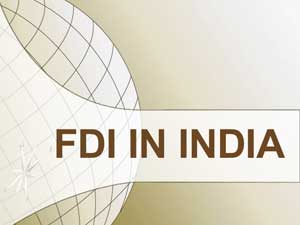India one among the top 10 destinations for foreign direct investment (FDI) in 2014
Sakshi Education
India moved up six places to become, for the first time, one of the top 10 destinations for foreign direct investment (FDI) in 2014, according to the United Nations Conference on Trade and Development (Unctad)'s World Investment Report 2015. It was 15th on the list in 2013.


FDI inflows into India were $34 billion in 2014, up 22 per cent rise from $28 billion in 2013. In fact, Inflows into the country were 83.5 per cent of South Asia's $41.2 billion, including Iran and the seven other member nations of the South Asian Association for Regional Cooperation.
Among the top 10 recipients, China, Hong Kong and the US accounted for the biggest share (in that order). China took the top spot with FDI of $129 billion in 2014 ($124 billion in 2013). The US, which attracted $231 billion worth of FDI in 2013, only garnered $92 billion in 2014. Hong Kong got $103 billion of FDI in 2014.
Others in the top 10 in 2014 were the UK (fourth), Singapore (fifth), Brazil (sixth), Canada (seventh), Australia (eighth) and the Netherlands (10th).
The Unctad report said India's FDI inflows would continue to rise in 2015 as an expected economic recovery gained ground.
In terms of structural composition, manufacturing is gaining strength, as policy efforts to revitalise the sector are sustained, including, for instance, the launch of the 'Make in India' initiative in mid-2014.
Under the 'Make in India' initiative, the Narendra Modi government has identified 25 industrial sectors in which India has the potential to be a world leader, including automotives, chemicals, pharmaceutical and textile industries.
In the manufacturing sector in South Asia, FDI success stories have emerged at country, industry and local levels, with the automotive industry in India showing how large-scale FDI inflows can reshape the trajectory of industrial progress in low income countries.
The report said automotive industry, which India opened up to FDI in 1991, was a key part of the Indian economy and had been identified as a key sector in which India could become a world leader.
The country accounted for most of the new investment projects announced by global automobile makers and first-tier parts suppliers in South Asia during 2013 and 2014, including 12 projects above $100 million, the report said. "Investment from the growing automotive industry in India shows potentials of a positive 'spillover effect' to productive capacity building in South Asia as a whole," the Unctad report said.
As an example, the report noted Mahindra's $200-million (about Rs 632-crore) proposed investment in a plant in Bangladesh for trucks and utility vehicles.
Among the positive trends in South Asia, the report said Pakistan and Sri Lanka were receiving greater FDI flows from China, Bangladesh saw an increase in new projects and Nepal was attracting more attention from multinational companies.
The report noted there was greater need for coherence between international taxation and investment policies. It said the policy imperative should be to take action against tax avoidance to support domestic resource mobilisation and to continue to facilitate productive investment.
Other important points
Among the top 10 recipients, China, Hong Kong and the US accounted for the biggest share (in that order). China took the top spot with FDI of $129 billion in 2014 ($124 billion in 2013). The US, which attracted $231 billion worth of FDI in 2013, only garnered $92 billion in 2014. Hong Kong got $103 billion of FDI in 2014.
Others in the top 10 in 2014 were the UK (fourth), Singapore (fifth), Brazil (sixth), Canada (seventh), Australia (eighth) and the Netherlands (10th).
The Unctad report said India's FDI inflows would continue to rise in 2015 as an expected economic recovery gained ground.
In terms of structural composition, manufacturing is gaining strength, as policy efforts to revitalise the sector are sustained, including, for instance, the launch of the 'Make in India' initiative in mid-2014.
Under the 'Make in India' initiative, the Narendra Modi government has identified 25 industrial sectors in which India has the potential to be a world leader, including automotives, chemicals, pharmaceutical and textile industries.
In the manufacturing sector in South Asia, FDI success stories have emerged at country, industry and local levels, with the automotive industry in India showing how large-scale FDI inflows can reshape the trajectory of industrial progress in low income countries.
The report said automotive industry, which India opened up to FDI in 1991, was a key part of the Indian economy and had been identified as a key sector in which India could become a world leader.
The country accounted for most of the new investment projects announced by global automobile makers and first-tier parts suppliers in South Asia during 2013 and 2014, including 12 projects above $100 million, the report said. "Investment from the growing automotive industry in India shows potentials of a positive 'spillover effect' to productive capacity building in South Asia as a whole," the Unctad report said.
As an example, the report noted Mahindra's $200-million (about Rs 632-crore) proposed investment in a plant in Bangladesh for trucks and utility vehicles.
Among the positive trends in South Asia, the report said Pakistan and Sri Lanka were receiving greater FDI flows from China, Bangladesh saw an increase in new projects and Nepal was attracting more attention from multinational companies.
The report noted there was greater need for coherence between international taxation and investment policies. It said the policy imperative should be to take action against tax avoidance to support domestic resource mobilisation and to continue to facilitate productive investment.
Other important points
- After 2008, for the first time, India again broke in to the top 10 recipients of foreign direct investment (FDI) during 2014, the UNCTAD
- India was at the 15th position in the previous two years.
- India, however, is the only BRIC (Brazil, Russia, India and China) country that hasn’t yet crossed the $50 billion-a-year FDI mark.
- China became the largest recipient of FDI in 2014 with $129 billion inflows, followed by Hong Kong (China) that received $103 billion and the U.S. with $92 billion.
- At 39 per cent, Hong Kong saw the biggest surge in inflows during the year.
- Russia dropped out of the top 10 as foreign investors exited its oil sector and other projects after western countries slapped economic sanctions on it. Among the top 10 FDI recipients in the world, half are developing economies - Brazil, China, Hong Kong (China), India and Singapore.
- In a development of significance to India, for the first time FDI inflows in to China’s services sector were greater than into its manufacturing sector.
- Global FDI fell 16 per cent to $1.23 trillion in 2014 mainly due to the fragility of the global economy, policy uncertainty for investors and elevated geopolitical risks, according to the report. New investments were also offset by some large divestments.
- India, however, dropped out of the top 20 countries in the outward FDI flows.
- The report also found that developing countries lost $100 billion in tax revenues owing to investors routing FDI through tax havens such as Mauritius, and has made a strong case for multilateral action to address the issue.
- The report records the big surge in investments from China into every region of the world, and especially in India’s neighbourhood.
- FDI inflows to Pakistan increased by 31 per cent to $1.7 billion as a result of rising Chinese FDI flows in services. Further, the country will benefit significantly from the China-Pakistan Industrial Corridor and associated Chinese investment in infrastructure and manufacturing in the overall context of implementing the “One Belt, One Road” strategy.
- According to agreements signed between the two governments in April 2015, Chinese companies will invest about $45.6 billion in Pakistan over the next few years — $33.8 billion in electricity and $11.8 billion in transport infrastructure.
- In Sri Lanka, where China has become the largest source of FDI in recent years, FDI flows from it rose. For example, a joint venture between two local companies and China Merchants Holdings (International) Company has invested $500 million in Colombo International Container Terminals, the largest foreign investment project in Sri Lanka. After two years of construction, the port started operation in August 2014.
- A China-Sri Lanka FTA will be signed in June 2015. Moreover, if the implementation of the China-led 21st Century Maritime Silk Route Economic Belt gains ground, an increasing amount of Chinese investment will flow to Sri Lanka, particularly in large infrastructure projects.
Published date : 25 Jun 2015 05:43PM













